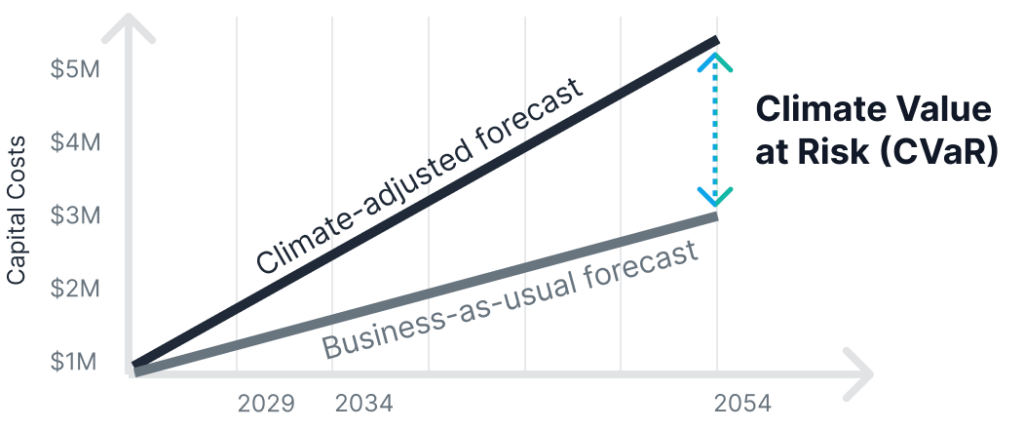What is Climate Value at Risk (CVaR) and how is it estimated?
Olivia Pink: At ClimateFirst we define Climate Value at Risk (CVaR) as the total anticipated increase in capital expenses due to a changing climate, compared to current circumstances. Our analysis is undertaken at the building-systems level, estimating the cumulative fiscal impact anticipated for critical building components over three future time frames (5, 10, and 30 years). We assess a comprehensive suite of climate perils, separately modelling the anticipated impacts of chronic and acute climate risks, under both a medium and high emissions scenario.

Why is it important to model chronic and acute climate hazards separately?
Pink: Chronic climate hazards, like increases in extreme heat and precipitation, can accelerate the degradation of critical building systems overtime. Whereas acute climate hazards, like flood, extreme wind, or wildfire, can result in the loss of an entire building, a portion of it, or a critical component—in a single “shock” event. These impacts on the building are different—as are the associated costs. As such, we model the CVaR for chronic hazards through analyzing the total extra costs due to the accelerated deterioration, and therefore early replacement, of critical building components during a designated period. It is the gap between what the expected costs are to maintain the function of these critical building systems in a changed climate versus the current climate that determines the estimated CVaR for chronic hazards.
For acute hazards, we define the CVaR as the estimated cumulative annualized loss for a designated period.
“To be credible—and actionable—CVaR assessments must apply both climate and building science and model identified hazards at a building-systems level. And those hazards—chronic and acute—require distinct types of analysis.”
Olivia Pink, Head of Science & Solutions, ClimateFirst
How does a CVaR assessment differ from a risk exposure screening?
Pink: There are different types of assessment the CRE industry can undertake to understand their physical climate risk. At ClimateFirst, we like to think of this as a “resiliency toolkit” with each type of assessment offering a different level of information and insight.
Risk exposure screens are what we consider a Level 1 assessment. These are a great starting point for commercial real estate owners and operators as they are a fast, and typically inexpensive, way to identify what climate hazards pose a threat to your property. A risk exposure screen will offer a rating or “score” for each applicable climate peril, providing insight into what climate hazards and properties are of greatest concern.
A CVaR assessment takes this hazard identification a step further and is what we consider a Level 2 physical risk assessment. Identified climate hazards are layered onto the building to undertake a systems-level analysis of how exposure to these climate perils impacts the critical building systems, and therefore their expected replacement cycles. This provides an estimation of the capital expenditure risk climate change poses to the building, unlocking risk management decisions.
Simply put, Level 1 assessments typically rank risks at a site level providing a colour code or number from 1-100. Level 2 considers how these site-specific hazards will impact the building specifically and puts a dollar value on them. And Level 3, which are more familiar to most, are traditional on-site engineering inspections.
Now what? How do we turn CVaR data into action?
Pink: Credible CVaR results enable different teams to execute their responsibilities more efficiently. For example:
- ESG teams have the data they need to accurately track and report physical climate risk and resiliency measures. This helps them not only meet stakeholder expectations but also achieve regulatory and/or disclosure requirements.
- Operations and risk management teams use CVaR results to identify which systems are of greatest concern and could benefit from immediate investment (i.e., protection measures, or strategic upgrades).
- And asset managers gain the valuable financial risk information they need to make informed transaction due diligence decisions.

